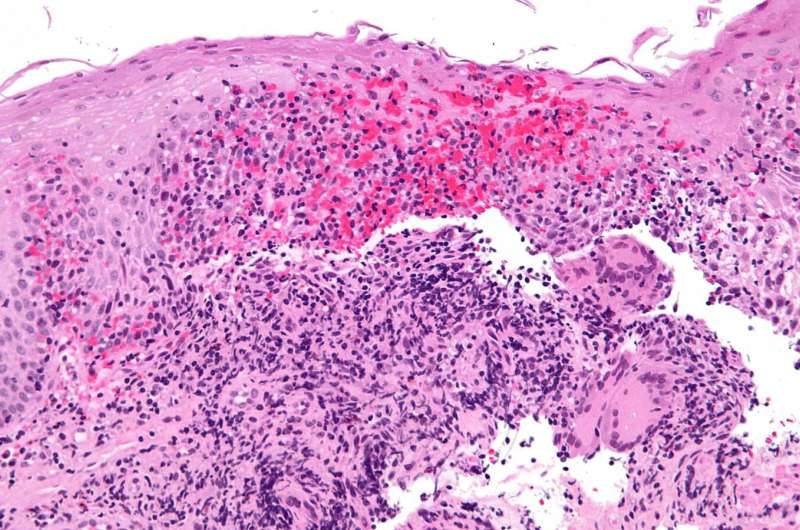
Many diseases have their origin in early human development, and today (8 September), two publications in Nature reveal how researchers from the Human Cell Atlas (HCA) consortium are advancing understanding of this. The global HCA initiative is mapping every cell type in the human body, to transform our knowledge of biology, infection and disease.
A new large-scale study mapped the cells in the human gut from early development through to adulthood, creating the most comprehensive cell atlas of the gut to date. This revealed that Crohn’s disease may be caused by activation of developmental pathways, and uncovered potential drug targets for treating Crohn’s and other inflammatory bowel diseases. The detailed maps will help explain how the gut forms and functions, and will transform research into intestinal diseases.
The second publication reveals the hugely ambitious plan to create an entire human developmental cell atlas (HDCA) of all cells that are important for healthy human development. The gut is just one example of the importance of this, and researchers from the Human Cell Atlas Developmental Biological Network and their collaborators worldwide show how they will chart developing tissues comprehensively in space and time. Key to understanding what happens in early development and how this can affect health or lead to disease, the HDCA is likely to lead to transformations in healthcare.
The gut is a complicated tissue made of multiple cell types, and changes enormously during early development. To understand how the gut develops and functions, researchers from the Wellcome Sanger Institute, Newcastle University, University of Cambridge and their collaborators within the Human Cell Atlas studied more than a third of a million individual gut cells from developing tissue and from child and adult donors.
Using cutting edge single-cell genomics and spatial analysis techniques, the team revealed which genes were active in each cell, and created a highly extensive gut cell atlas through time and across 12 regions of the intestines.
Rasa Elmentaite, first author on the study from the Wellcome Sanger Institute, said, “By studying multiple regions of the human gut throughout development, childhood and adulthood we’ve created a unique, detailed map of the healthy human gut. This gut cell atlas reveals complex developmental events, including how the immune and nervous systems develop in the healthy gut, and identifies important differences along the intestines. The data is openly available to other researchers studying the gut, and will undoubtedly contribute to future discoveries.”
The study also included gut biopsy tissue from children with Crohn’s Disease. This, in combination with the data from healthy development, is giving new insights into rare and common diseases of the intestines.
Dr. Kylie James, a senior author on the paper, who carried out the work at the Wellcome Sanger Institute, and is now at the Garvan Institute of Medical Research, Australia, said, “This gut cell atlas is already shedding new light on the origins of Crohn’s and other intestinal diseases. For example, we identified three key cells that attract immune cells to form lymphoid tissue during development, and showed that this same developmental pathway may cause Crohn’s Disease. This knowledge is helping researchers identify potential new drug targets for gut diseases.”
While the gut atlas is one example of how understanding development can shed light on disease, a mammoth effort is already underway to create an entire human developmental cell atlas (HDCA), to transform our understanding of health and disease. The detailed roadmap of how researchers from the HCA Developmental Biological Network plan to create these genomic reference maps of cells, tissues and organs during different stages of healthy human development is revealed in a perspective paper in Nature today.
Professor Muzlifah Haniffa, a coordinator of the Developmental Biological Network, from Newcastle University and the Wellcome Sanger Institute, and a senior author on both papers, said, “The Human Developmental Cell Atlas will provide a vital resource to understand many aspects of biology and disease, in order to improve human health. Our roadmap shows the progress we’ve achieved so far, including creating a gut development atlas, how we plan to overcome challenges to achieve a complete atlas of human development, and how this will be used to understand disease.”
Coordinated across the globe by Professor Muzlifah Haniffa, Professor Sten Linnarsson and Professor Deanne Taylor, the HCA Developmental Biological Network will bring together many teams of researchers worldwide, sharing data and ethics resources. The cross-disciplinary community will analyze and combine data from different stages of development creating 3-dimensional organ and whole embryo maps of development across space and time.
Professor Deanne Taylor, a coordinator of the Developmental Biological Network, from the Children’s Hospital of Philadelphia, U.S., and a senior author on the paper, said, “Creating the Human Developmental Cell Atlas is an enormously complex task, using state-of-the-art technologies. The atlas will be a hugely important resource, not only for understanding healthy development, but also for understanding many types of diseases and disorders that first manifest in children.”
Working towards understanding how tissues develop and grow, more than 600 researchers attended the first HCA Developmental and Pediatric Cell Atlas meeting, 25-27 August 2021. They connected virtually, forging new collaborations and exchanging knowledge, inspiration and ideas, and recordings of the talks are now available.
The Human Developmental Cell Atlas data will be openly available, and will have applications for finding drug targets, engineering human cells for research or screening, and ultimately even as therapeutics for regenerative medicine.
Source: Read Full Article
